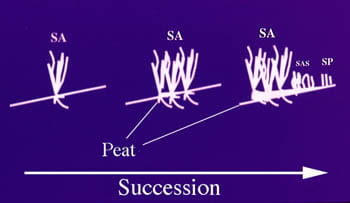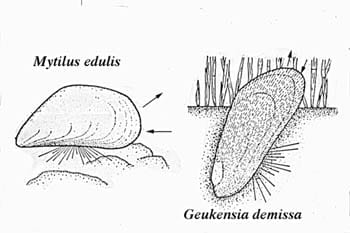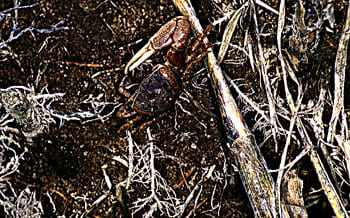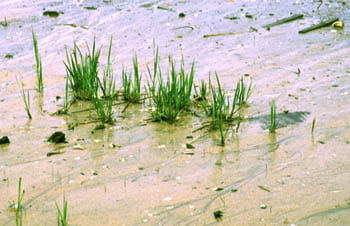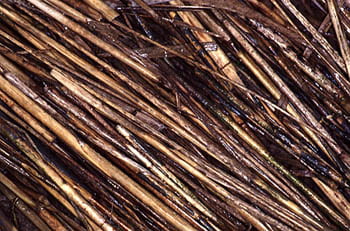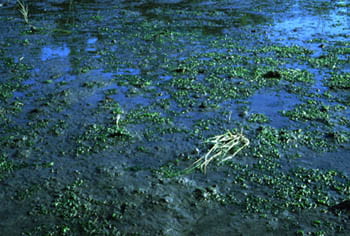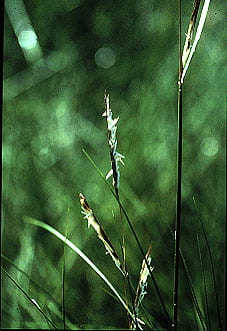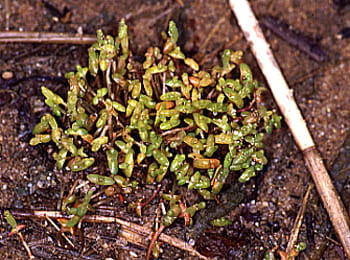Spartina salt marshes are broad nearly level meadows dominated by several species of grasses that are tolerant of salt and anoxic sediment. Broad meadows are interspersed with creeks that are biologically rich, owing to the rich supply of organic matter and the provision of protected habitats for many species.

Spartina is a terrestrial flowering plant, with underground roots that extend below ground horizontally in a rhizome system, where shoot come up a few cm or more from the original plant. But below ground there is a complex microbial system associated with the roots, including a microbial mycorhizae system, that takes up nitrogen. The ribbed mussel Geukensia demissa attaches to these roots. It feeds on suspended phytoplankton, but its biodeposits introduce nutrients, especially nitrogen, into the marsh sediments. So we have a complicated plant-microbial-animal interactive system.
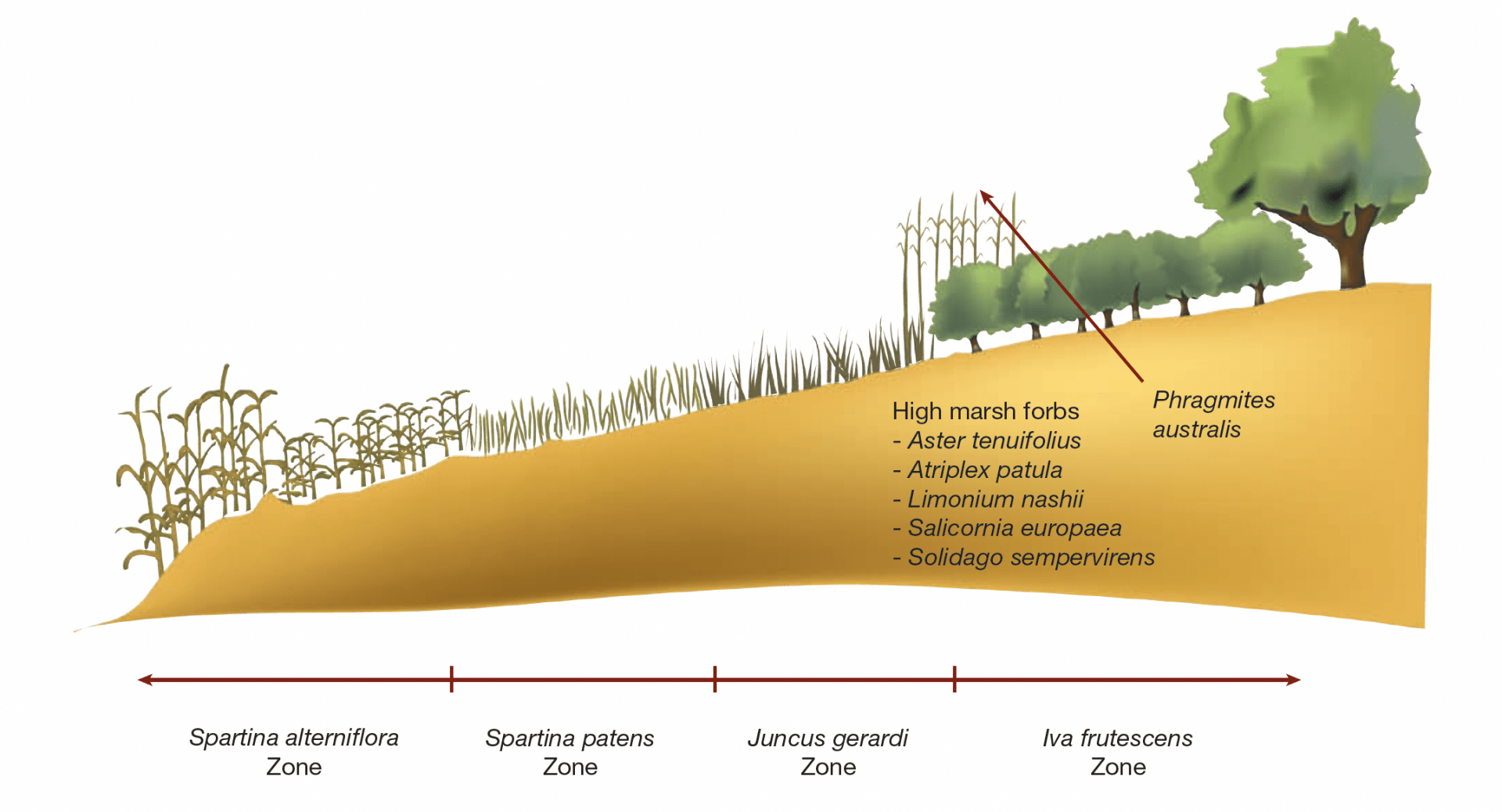 Spartina meadows have a general zonation as pictured above (this is adapted from figure published by Bertness et al. 2002). This zonation works when there is a simple incline but West Meadow has a complex meadow with ups and downs, so the simple zonation is often not present. But the salt grass Spartina alterniflora is usually lowest and terrestrial plants like marsh elder are highest.
Spartina meadows have a general zonation as pictured above (this is adapted from figure published by Bertness et al. 2002). This zonation works when there is a simple incline but West Meadow has a complex meadow with ups and downs, so the simple zonation is often not present. But the salt grass Spartina alterniflora is usually lowest and terrestrial plants like marsh elder are highest.

Marsh elder Iva frutescens is a terrestrial shrub, found above the highest salt marsh plants.

Sea lavendar Limnonium carolinanum comes into flower in July-August and is found above the highest salt marsh grasses. Plants are usually about 12 inches high.
A salt marsh is “born” by the arrival of a seed or the rafting of a plant of the cord grass Spartina alterniflora. The grass spreads asexually by means of a subterranean rhizome system. The grass becomes dense and forms a baffle, which encourages the deposition of fine particulate sediment, including organic matter (salt marsh peat). This, in effect, causes a rise of the sediment surface and makes the habitat more terrestrial. As this happens, other somewhat less salt-tolerant grasses are able to invade. Eventually, this series of invasions and takeovers leads to a vertical zonation of grasses and a spread of the entire marsh system.
SAS = Spartina alterniflora – short form
SP = Spartina patens, the next higher grass species
In the foreground we see the Spartina patens zone, which is higher (though that is hard to tell from the photo) than the S. alterniflora zone (taller grass in the background). S. patens is less salt tolerant than S. alterniflora.

This is a schematic cross section of a marsh with creeks. Note the tall form of Spartina alterniflora, which tends to live adjacent to creek edges, which are bathed in nutrient-rich water. The short form lives in higher sites away from creek edges. The ribbed mussel Geukensia demissa often lives among Spartina spp. and its production of nitrogen-rich feces and pseudofeces enhances grass growth.
(after Stanley, S.M., 1970, GSA Memoir 125)
The high intertidal marsh mussel Geukensia demissa is ubiquitous in Spartina salt marshes. The late Charles Lent showed that this mussel was capable of breathing air, and often got more of its oxygen from air than from water.
The diagram at left shows that Geukensia demissa is more elongate than the mussel Mytilus edulis, and lives semi-infaunally in the sediment, with byssal threads attached to sedimentary grains or rhizomes of Spartina. Steven Stanley demonstrated that the musculature apparently helps in dragging the mussel down into the sediment, as opposed to that of M. edulis, where the foot retractor muscles act to appress the mussel to the rocks.
Ribbed mussels can be quite densely packed. Mark Bertness and colleagues demonstrated that this mussel enhances the growth of Spartina grass. The mechanism may relate to biodeposition of nitrogen-rich feces and pseudofeces. The byssal threads of this mussel also help bind the sediment and may retard erosion. Another common salt marsh resident, the fiddler crab Minuca pugnax, also aids in Spartina growth by burrowing and aerating the sediment. Note the barnacles attached to mussel shells, which is possible owing to the mussel’s semi-infaunal habit.
Ribbed mussels are found in a very special edge habitat. They benefit from attaching to marsh grass shoots, but they also benefit the marsh by virtue of their holdfasts, which tie together the marsh edge. In some places one can see that the ribbed mussels comprise a dense edge of the marsh. They are holding the peat together and providing a firm border holding the marsh edge together as well. Here is an example one can see right near the Ernst Center.

Healthy marsh edge. Ribbed mussels in healthy marsh edge, attached to grassroots within sediment-peat.

Retreating marsh edge. Marsh grass has withdrawn (edge at top of photo) and ribbed mussels are left in peat. They have no marsh roots to attach and will likely be eroded out of the peat.
A new section of marsh must start by the colonization of a seed or by rafting of an adult. In this case, a clump was initiated probably by arrival of a seed, but all of the plants in this picture are connected by a rhizome, suggesting that this small founding population arose from a single successful colonizing seed.
Courtesy of Mark Bertness, Photo by Irv Mendelssohn
The aerenchymal tissue allows Spartina to exchange gases, even when surrounded by an anoxic soil. The tissue in this photograph is visible as a series of circular passageways around the periphery. Plants cannot use nutrients efficiently without oxygen, so this tissue allows a connection between the aerobic leaves to the stems, that are surrounded usually by anoxic water.
In the fall, Spartina leaves senesce and eventually calve off at the base. This material then is deposited on the sediment surface. By the time the particulate organic material is deposited on the surface, nearly all nitrogen has been removed by microbes, so it is very carbon rich and nitrogen poor. The carbon is mainly in the form of cellulose, which is largely indigestible by invertebrates.
The senesced leaves accumulate on the sediment surface as shown at left. This material will smother any grass beneath, but a high spring tide or a storm may remove it all quite rapidly and transport it out of the marsh system to the shelf.
This material has been the source of much controversy over its value as food to marine invertebrates. On the one hand it consists mainly of virtually indigestible cellulose. But, when broken into small particles, it can be a substratum for bacteria and microalgae, and may be consumed by animals such as oysters.
This meadow is rather high in the intertidal and is dominated by Spartina patens, which occurs higher in the intertidal zone than S. alterniflora. S. patens is less salt-tolerant than S. alterniflora. In the foreground is a small band of S. alterniflora.
The picture was taken at Flax Pond, a salt marsh on the north shore of Long Island, near Stony Brook, New York.
Here again we see a lovely Spartina alterniflora salt marsh in the fall. In the foreground is a mud flat that is covered with the sea lettuce Ulva rotundata, which decomposes and is a source of nutritious and digestible particulate organic matter for the benthic invertebrates in the flat.
Here we see a large patch of Spartina alterniflora that is overgrowing a mud flat. “Cage” arrows point to cages that were used in an experiment to study the competitive interactions between the mud snails Ilyanassa obsoleta and Hydrobia totteni. The larger Ilyanassa obsoleta displaces Hydrobia.
courtesy of Mark Bertness
A large area of salt marsh may be covered by wrack for some time, which probably smother the underlying plants. In the high intertidal and supratidal, such open bare areas are prone to strong evaporation and salt deposits begin to accumulate. Research by Mark Bertness shows that the salt depresses seed germination and invasion by surrounding plants, making the salt pan a locally stable state.
Courtesy of Mark Bertness
Salt pans are stable states, unless a heavy rain occurs that can dissolve the salt and allow seeds to germinate. Sometimes a plant or group of plants may be able to spread into a favorable microsite in the salt pan. D. spicata can spread into the marsh by forming runners, which allows a group of plants to shoot up. This creates a local spot where shade permits water to dissolve salt faster than it precipitates, which may allow yet more plants to spread via a rhizome system and may also allow more seeds within the sediment to germinate.

Spartina alterniflora in flower
Spartina alterniflora consists of tough leaves composed of cellulose. Very few grazers attack the plant. The flowers, however, are consumed by a large number of insect grazers, which often cause a failure of seed set.
Courtesy of Mark Bertness

Melampus bidentatus (source Carnegie Museum of Natural History)
If you turn over a piece of wood or look at high intertidal grass blades at the time of low tide, you might find this snail, which is only a few mm in length. It is a pulmonate snail and therefore must be in air for some part of the day to get oxygen, but maybe not, since I have kept them under seawater for several days and they did not drown. Unlike other pulmonates, it has a planktonic larva, which swims for two weeks. Larvae are released at the time of spring high tide and settle high in the marsh at the next spring high tide. This maximizes the chance that they will release larvae when they are covered by water and that the larvae can settle in a part of the tide zone that is exposed to air for most of the day.
Several species of Salicornia can be found in eastern American Spartina salt marshes in the highest part of the intertidal zone. They are all very salt tolerant. This plant is only about 5 cm high.
This individual is standing on the periphery of a salt creek, stalking prey, which may include smaller fish and crabs.
MARSHES IN TROUBLE FROM POLLUTION AND CLIMATE CHANGE
Salt marshes have been in trouble for many decades. We love to live along tidal creeks, but our septic tanks and lawn treatments add nutrients to the creek, which alters the interactions between salt marsh plants. Nutrients tend to favor the low marsh Spartina alterniflora, which may extend to higher portions of the marsh. This may squeeze out other species, and those dependent upon them, like the salt marsh sparrow. In general, we have seen retreat of the lower end of salt marshes along West Meadow Creek, as has happened for other salt marshes in our region. The reason for this is unclear, but if you look you can see bare patches at the water’s edge, that was one covered by Spartina alternifora. In the long run, sea level rise tends to move the lower Spartina alterniflora upwards in the marsh. Sea level has risen steadily in Long Island Sound since the melting of the continental glaciers, but sea level rise is being accelerated by global warming, which expands the ocean volume and also causes melting of high latitude ice, which adds further to sea level. In total, this will cause low marsh plants to grow higher, and there may be no place for the upper marsh to go, given that we build streets, houses and therefore prevent any natural advancement of the marsh as sea level rises.

